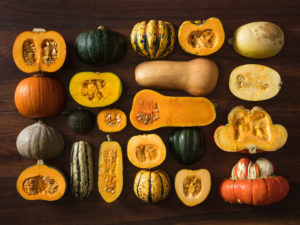Preserving Winter Squash and Pumpkins
go.ncsu.edu/readext?740711
en Español / em Português
El inglés es el idioma de control de esta página. En la medida en que haya algún conflicto entre la traducción al inglés y la traducción, el inglés prevalece.
Al hacer clic en el enlace de traducción se activa un servicio de traducción gratuito para convertir la página al español. Al igual que con cualquier traducción por Internet, la conversión no es sensible al contexto y puede que no traduzca el texto en su significado original. NC State Extension no garantiza la exactitud del texto traducido. Por favor, tenga en cuenta que algunas aplicaciones y/o servicios pueden no funcionar como se espera cuando se traducen.
Português
Inglês é o idioma de controle desta página. Na medida que haja algum conflito entre o texto original em Inglês e a tradução, o Inglês prevalece.
Ao clicar no link de tradução, um serviço gratuito de tradução será ativado para converter a página para o Português. Como em qualquer tradução pela internet, a conversão não é sensivel ao contexto e pode não ocorrer a tradução para o significado orginal. O serviço de Extensão da Carolina do Norte (NC State Extension) não garante a exatidão do texto traduzido. Por favor, observe que algumas funções ou serviços podem não funcionar como esperado após a tradução.
English
English is the controlling language of this page. To the extent there is any conflict between the English text and the translation, English controls.
Clicking on the translation link activates a free translation service to convert the page to Spanish. As with any Internet translation, the conversion is not context-sensitive and may not translate the text to its original meaning. NC State Extension does not guarantee the accuracy of the translated text. Please note that some applications and/or services may not function as expected when translated.
Collapse ▲The signs of Fall are all around us. Trees are turning colors, there is a crispness to the air, and of course, pumpkins and Fall decorations. But did you know that pumpkins and squash can be preserved for use during the Winter months?
Pumpkins and squash can be preserved for later use by freezing, canning or drying. 
They should have a hard rind and stringless mature pulp. Small size pumpkins (sugar or pie varieties) make better products.
Freezing is the only safe method for preserving pumpkin purees, butters and preserves.
- Select full-colored, mature pumpkins with fine texture.
- Wash, cut into cooking-size sections and remove seeds.
- Cook until soft in boiling water, in steam, in a pressure cooker or in an oven.
- When soft, remove pulp from rind and mash.
- To cool, place the pan containing the pumpkin in cold water and stir occasionally.
- Pack into rigid containers leaving ½-inch headspace and freeze.
For best results, freeze these items for up to 1 year. Frozen pumpkin or squash is great to use in pies, desserts and as a vegetable. Thaw pumpkin and squash in the refrigerator – not on the counter – before using.
Canning pumpkin or winter squash puree is not safe. The density of this product prevents adequate heat transfer to the center of the jar and may allow harmful bacteria to survive. Pumpkin and winter squash needs to be cubed and canned using a pressure canner.
To can pumpkin or squash:
- Cut the flesh into 1-inch cubes.
- Boil the cubes in water for 2 minutes.
- Fill the jars with cubes and cooking liquid, leaving 1-inch of headspace.
- Pumpkin and squash are low-acid vegetables and must be pressure canned. Process the vegetables at:
- 12 pounds pressure in a dial gauge pressure canner.
- Or 15 pounds pressure in a weighted-gauge pressure canner.
- For either method, process pints for 55 minutes and quarts for 90 minutes.
To use canned pumpkin or squash, drain the jars, mash the cubes and re-heat.
Pumpkin and squash can also be preserved by drying it.
- Wash, peel and remove fibers and seeds from pumpkin or squash flesh.
- Cut into small, thin strips, no more than 1 inch by 1/8 inch.
- Blanch strips over steam for 3 minutes. Drain and pat dry.
- Dry the strips in a dehydrator until brittle.
- To reconstitute, use 1 cup of dried food to 2 cups of water.
- Pre-soak for 1 hour and then boil until tender.
1 cup of dried pumpkin or squash is enough for one pie.
Pickling is another option, but cannot be safely canned using a hot water bath or pressure canner. These products need to be stored in the refrigerator. Pumpkin or squash in pickled products such as salsas, chutneys and relishes.
Refrigerate or freeze pumpkin butters and gelled preserves to ensure they will be safe to eat. Pumpkin butters and gelled preserves cannot be safely canned for room temperature storage.
Pumpkin and squash are low-acid foods and require special attention to preparation and processing. Currently, the USDA does not have any tested recipes for safely canning pumpkin preserves (jams, jellies, conserves or pumpkin butter).
Enjoy Fall and all those pumpkins and Winter squashes, but do so safely. If you have questions, give us a call.




